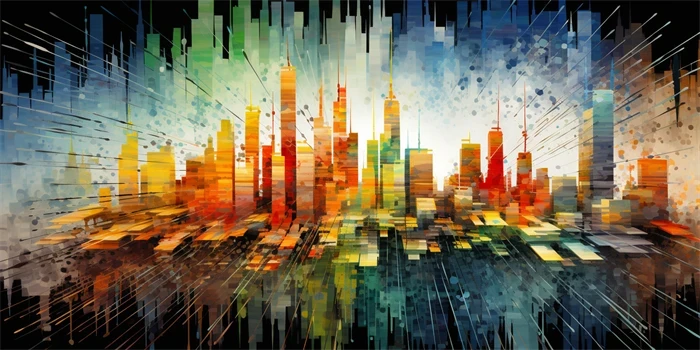Virtual reality (VR) has revolutionized the way we experience digital content, transporting us to worlds far beyond our imagination. However, the key to a truly sensational VR experience lies in the level of visual realism it can offer. This is where artificial intelligence (AI) comes into play, enhancing the graphics and creating an immersive environment that feels almost indistinguishable from reality. In this article, we will explore how AI enhances visual realism in immersive virtual reality in several aspects.

1. Realistic Environments
AI algorithms can generate realistic virtual environments by analyzing real-world data. For example, machine learning algorithms can process vast amounts of images and videos to understand the intricate details of different landscapes, buildings, and objects. This enables VR developers to recreate these elements in a virtual setting, resulting in stunningly lifelike environments.
AI algorithms can also dynamically generate virtual landscapes that adapt to user inputs or environmental factors. This means that VR experiences can be truly unique and personalized, offering endless possibilities for exploration.
2. Lifelike Characters
AI-powered character animation is another key factor in enhancing visual realism in VR. Traditional animation methods often result in stiff and unrealistic character movements. However, by utilizing AI algorithms, developers can create more natural and fluid animations.
AI can learn from motion capture data, analyzing the movements of real-life actors and translating them into virtual characters. This process, known as motion transfer, produces lifelike movements that elevate the immersive experience. AI can also generate facial expressions and subtle nuances that add realism and depth to virtual characters.
3. Real-time Rendering
One of the challenges in VR is rendering realistic visuals in real-time. AI algorithms, such as neural networks, can significantly accelerate this process. By learning from large datasets of pre-rendered images, AI can generate real-time rendering techniques that mimic the lighting, shadow, and texture effects found in the real world.
Real-time rendering powered by AI allows VR experiences to achieve a level of visual fidelity that was previously impossible. It creates a seamless and immersive experience where users can explore virtual environments without any visual discrepancies or lag.
4. Enhanced Textures and Details
AI algorithms can enhance the textures and details of virtual objects, giving them a more realistic look and feel. Through a technique called super-resolution, AI can generate high-resolution textures and models from low-resolution inputs.
This allows VR developers to create detailed and intricate objects without sacrificing performance. The use of AI in texture generation also reduces the need for manual texture mapping, saving time and resources during VR content creation.
5. Natural Physics and Interactions
AI algorithms can simulate real-world physics and interactions within the virtual environment. By analyzing physical properties and behaviors, AI can accurately replicate the movement and interaction of objects in VR.
For example, AI can simulate the realistic behavior of water, smoke, or cloth, adding another layer of authenticity to the immersive experience. This level of realism enhances the sense of presence and makes interactions within the virtual world feel more natural and intuitive.
6. Adaptive AI-based Soundscapes
AI can also enhance the audio aspect of VR experiences by creating adaptive soundscapes. By analyzing the user’s movement and interactions, AI algorithms can dynamically adjust the audio sources and effects to match the virtual environment.
For instance, if the user is exploring a virtual forest, AI can generate realistic sounds of chirping birds, rustling leaves, and gentle wind. This adaptive soundscape adds an extra layer of immersion and makes the VR experience more engaging and captivating.
7. AI-based Virtual Reality Content Creation Tools
AI has also revolutionized the process of creating VR content. AI-based tools and software automate various aspects of content creation, such as environment generation, character animation, texture mapping, and physics simulation.
For example, platforms like Artomatix and Topaz Labs use AI algorithms to assist artists in generating realistic textures and automating repetitive tasks. These tools not only streamline the content creation process but also improve the overall quality and realism of VR experiences.
8. Advancements in Eye-tracking Technology
Eye-tracking technology, combined with AI, has the potential to enhance visual realism in VR even further. By tracking the user’s eye movement, AI algorithms can optimize graphics rendering in real-time.
This means that VR headsets can focus on rendering high-resolution graphics only where the user’s eyes are looking, while reducing the rendering quality in the peripheral vision. This technique, known as foveated rendering, significantly improves performance and allows for more realistic visuals in VR.
FAQs:
Q: Can AI completely replicate reality in VR?
A: While AI has made significant advancements in enhancing visual realism in VR, complete replication of reality is still a challenge. However, the combination of AI with other technologies, such as haptic feedback and advanced motion capture, brings us closer to a more immersive and realistic VR experience.
Q: Does AI-powered VR require high-end hardware?
A: AI-powered VR experiences can benefit from high-end hardware, but advancements in AI algorithms and optimization techniques allow for improved performance even on lower-end devices. As AI algorithms continue to evolve, the hardware requirements for a realistic VR experience are expected to become more accessible.
Q: How does AI impact the development cost of VR experiences?
A: AI can reduce the development cost of VR experiences by automating various tasks involved in content creation, such as environment generation and character animation. Additionally, AI-based tools and platforms make it easier for artists and developers to create high-quality VR content without extensive manual work.
References:
1. “How AI Is Creating Photorealistic Worlds in VR” – NVIDIA Developer Blog
2. “Artomatix: Changing the Way Games are Designed” – Artomatix Website
3. “Foveated Rendering: A Game Changer for VR” – Next Reality VR








